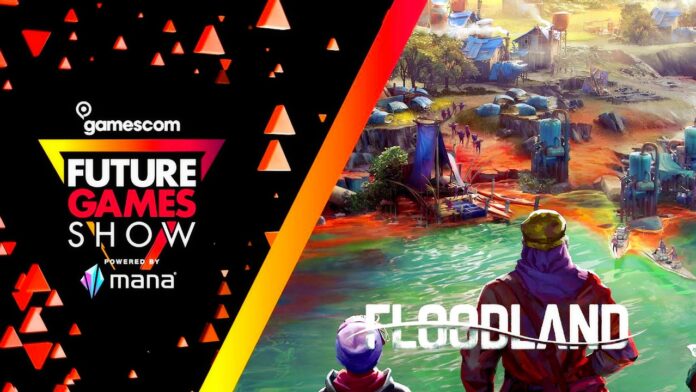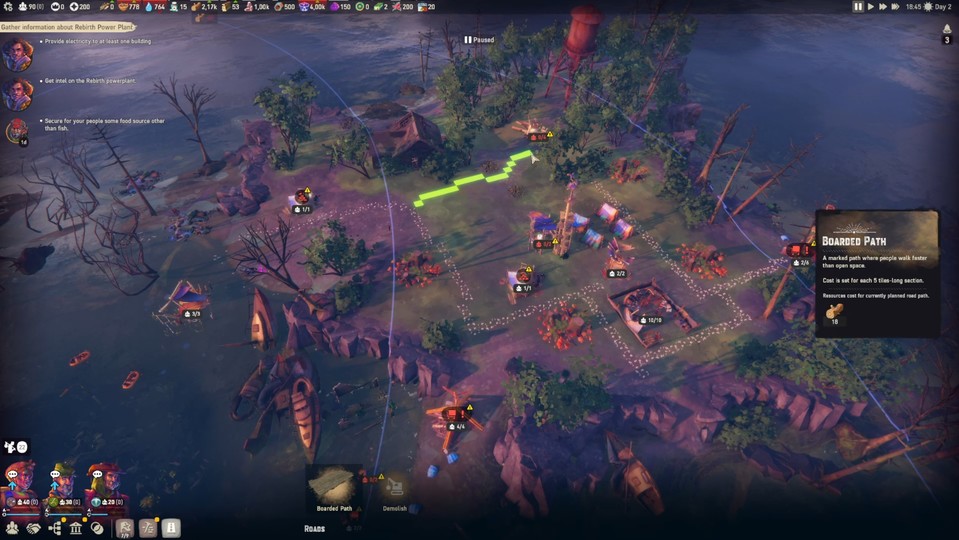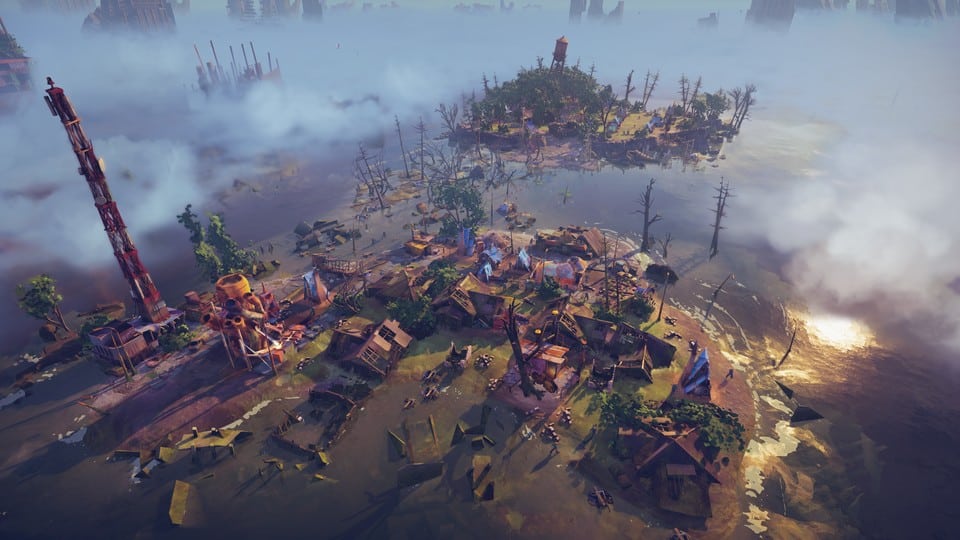Floodland looks like a painting and combines survival building with role-playing elements so cleverly that our gamescom appointment flew by.
A little peek behind the scenes at gamescom: Basically, one of the most relaxed developer jobs there is to supervise gameplay stations. Just watch with interest and take a few notes. Questions are usually rarely asked here because people are far too focused on playing.
Usually. Unless the game being supervised is called Floodland. Because the new and promising building title by Vile Monarch (Weedcraft Inc., Oh…Sir!) bombards you with so many challenges and tricky decisions that the supervising developers can”t get out of explaining and helping.
Despite this, or perhaps because of it, after my 60 minutes with Floodlands I could only leave the game with a heavy heart. There were still so many interesting things to do!
What makes Floodland special
In Floodland, climate catastrophe has become a bitter reality, leading first to rising sea levels and eventually to the flooding of North America, along with the loss of all communications and electronic equipment.
You take responsibility for a clan of survivors in order to rebuild something resembling a functioning society from the flooded ruins.
Floodland combines classic city building with survival aspects, story elements and hard, often politically connoted decisions and is thus reminiscent in many respects of the great Frostpunk. However, it differs from the obvious role model in two important points.
More micromanagement: In Floodland, you don”t just build tents, fisheries and schools, but also assign and prioritise every single work order – from collecting resources to exploring the environment to looking after the individual buildings. It”s only logical that you usually have less manpower than you actually need.
More exploration: At the beginning of a game you only see a tiny fraction of the (really huge) map, everything else lies under a thick fog like in a classic real-time strategy game and needs to be explored first. On the one hand because you suffer from a constant shortage of resources due to the scenario, on the other hand because you can meet other clans that may even join you under certain circumstances.
Which is already great
No idle time thanks to high demands: Even in Frostpunk, you eventually reach a point where everything goes as it should – until the next catastrophe throws the planning more or less out of whack. But in my 60 minutes with Floodland, things never went as they should!
Sometimes my survivors spoiled their stomachs with raw fish because I couldn”t get enough building material for a kitchen in time. Sometimes the mood of my clan sank because of a political decision. Sometimes I couldn”t find raw materials I desperately needed, to no avail.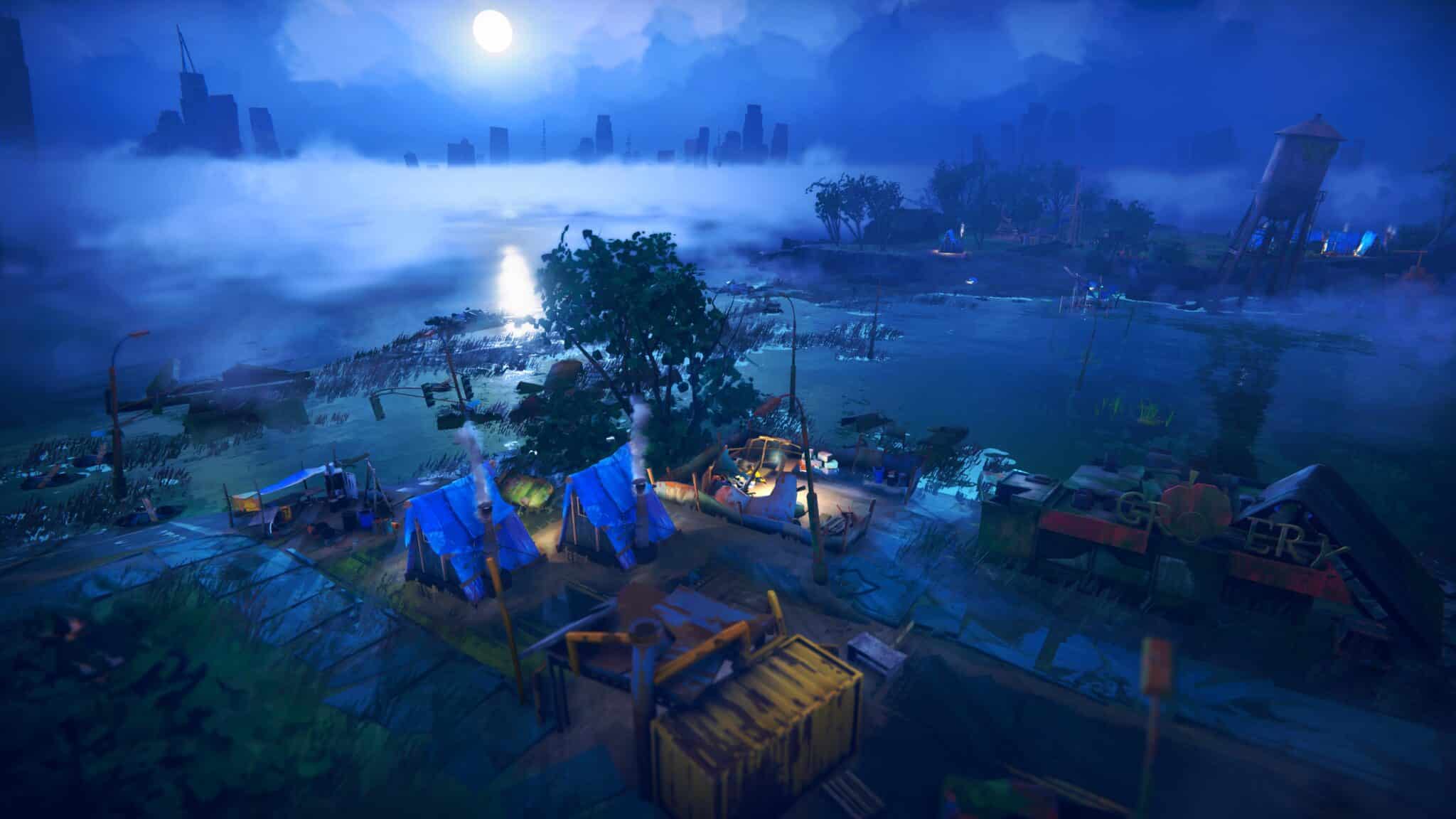
The amazing thing: I never felt annoyed, stressed or frustrated, but always challenged. There must be some kind of solution! It is certainly helpful that, unlike in Anno 1800, I can also analyse the situation and give orders in pause mode.
Exploration motivates: I wouldn”t have thought how much exploring a map can enrich a building game. In Floodland, I expand my radius not only out of a survival urge in search of resources, but also out of pure curiosity as to what might be waiting for me around the next bend in the river. Perhaps a ruin that I can loot? Maybe finally a suitable place for a second central camp? Or maybe even a new clan I can get in touch with?
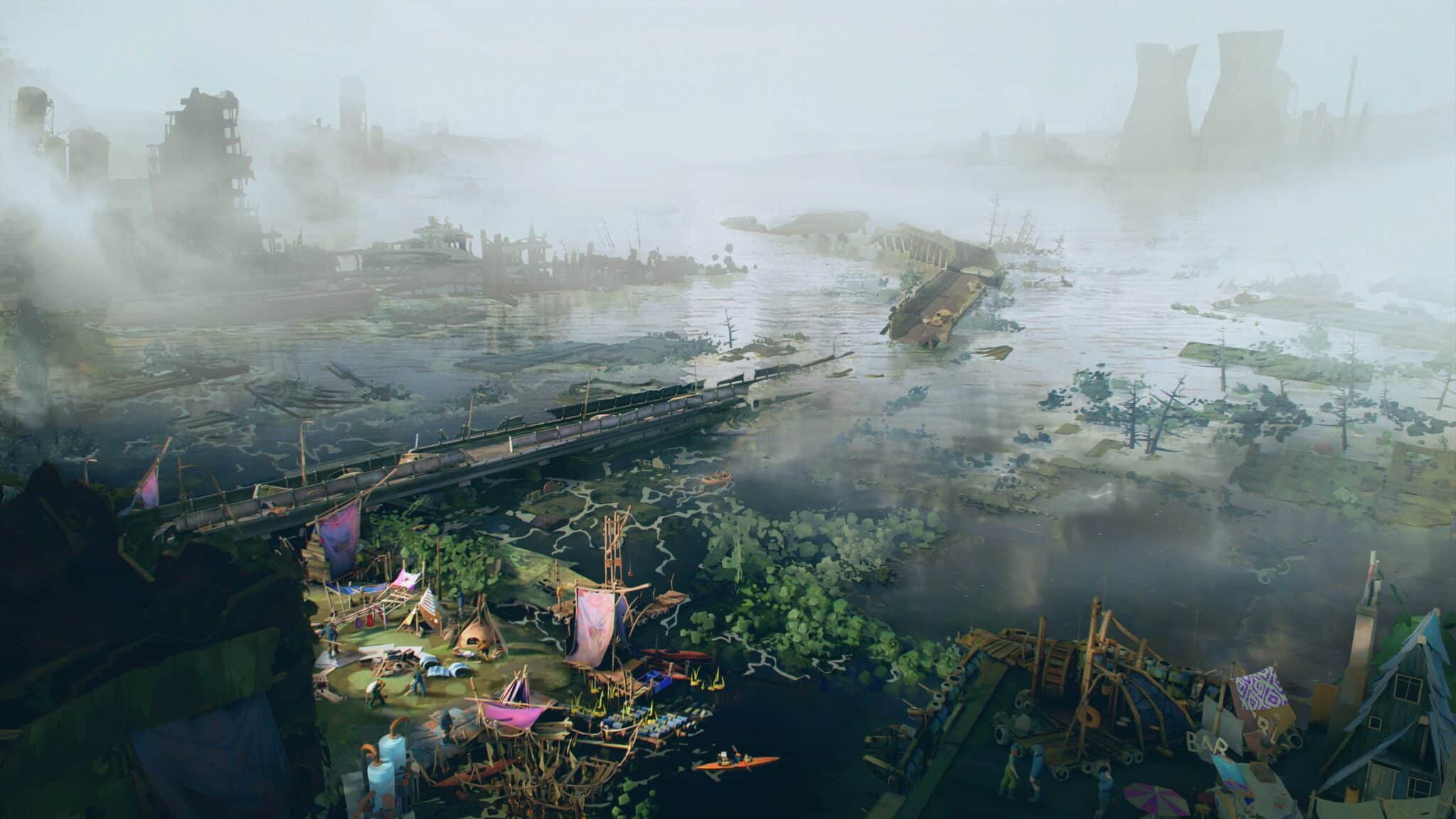
All this is supported by a very atmospheric and organic looking map design. Floodland assembles its maps from prefabricated elements and then randomly but logically distributes resources and possible discoveries, which should ensure a high replay value.
There is really a lot in it: Floodland really has everything I expect from a modern survival construction game and so much more. Right at the beginning of the game, I can choose between four different clans, each of which has different bonuses, but also different political views.
I follow a story that is divided into chapters, in the course of which I have to make tough decisions again and again. I collect experience points to upgrade the abilities of my clan, just like in a role-playing game.
And I gradually open up a widely ramified research tree to unlock not only dozens of buildings, but also technologies like electricity that turn my settlement planning completely inside out again. In any case, Floodland will provide a whole lot of material to really let off steam in terms of building strategy.
What should be even better
The brittle production: Floodland is one of the very rare games that looks more beautiful in pictures than in motion. For as atmospheric as the watercolour style comes across, so much atmosphere is lost through the sparse animations and drab text windows.
In addition, the washed-out look detracts a little from the overview. Floodland compensates for this with many overlays in the game world, which meant that the graphic style could only rarely unfold its full effect on me.
The story campaign doesn”t pull in yet: In theory, Floodland wants to tell an exciting story of how the survivors fight their way back into a functioning social order, having to make tough decisions along the way, and get to the bottom of the mystery of what really caused the final catastrophe.
Of course, you can”t expect elaborate cutscenes from an indie title, but the long and as yet unvoiced texts still left me cold when I played the game, which of course could also be due to the hustle and bustle of the trade fair.
The unclear user guidance: The fact that my poor survivors were poisoned with spoiled fish was not only due to my own stupidity (honest!), but also because I checked far too late how the food processing works. Buildings only appear in the construction menu after you have researched them, but you have to find them first in the hitherto terribly confusing tech tree.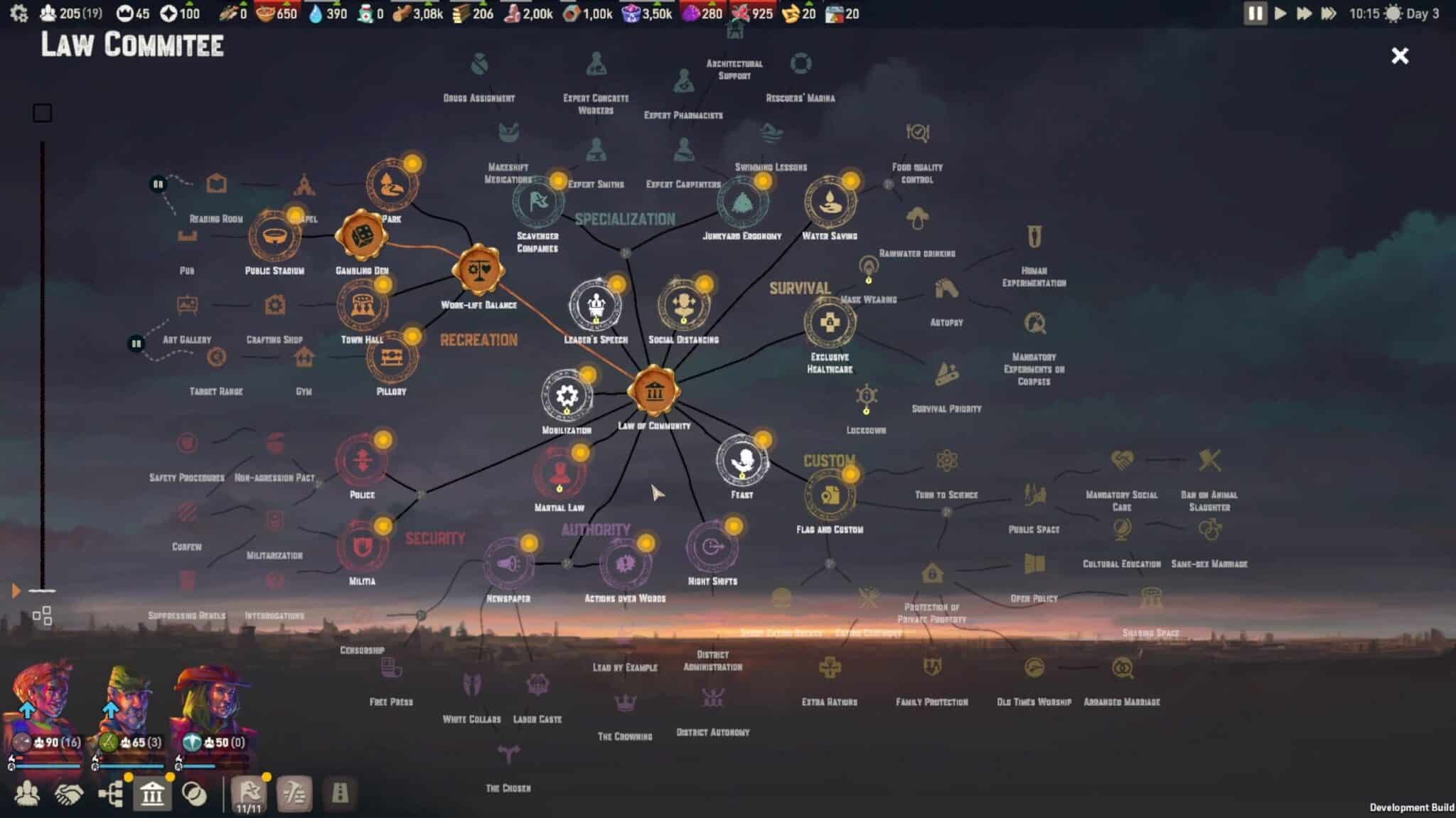
Why I have to click on the camp to change task and building priorities is also beyond me. It”s quite possible that I overlooked the crucial tutorial hints in the stress of the fair. But measured against the extraordinary stress of the developers in charge, I was definitely in good company as far as the lack of understanding was concerned.
On the other hand, it”s been a long time since my ambition for building strategy was tickled like it was in Floodland.
Editor”s Verdict
Heidewitzka, there I am, as an old construction enthusiast, looking forward to a relaxed tinkering at the end of the fair and suddenly I have to drive my brain cells to maximum energy! Floodland looks harmless and artistic, but in terms of ambition it can easily compete with Frostpunk and Anno 1800. I give the game credit for the fact that it is never stressful, but just tricky – that”s how it should be! You quickly notice that an experienced studio is pursuing a clear vision here.
Visually, however, Floodland was less convincing. Although the watercolour style fits the theme wonderfully in principle, it is of little use if I have to rely on far less beautiful panels and fades for lack of legibility.
The user guidance, which is in need of optimisation, also makes it unnecessarily difficult for me to get to grips with the fight for survival. But the more I understood, the more I was fascinated by the well thought-out interplay of classic city building, motivating exploration, tricky decisions and small role-playing elements. And that really makes Floodland a really promising building game for genre lovers for me.

